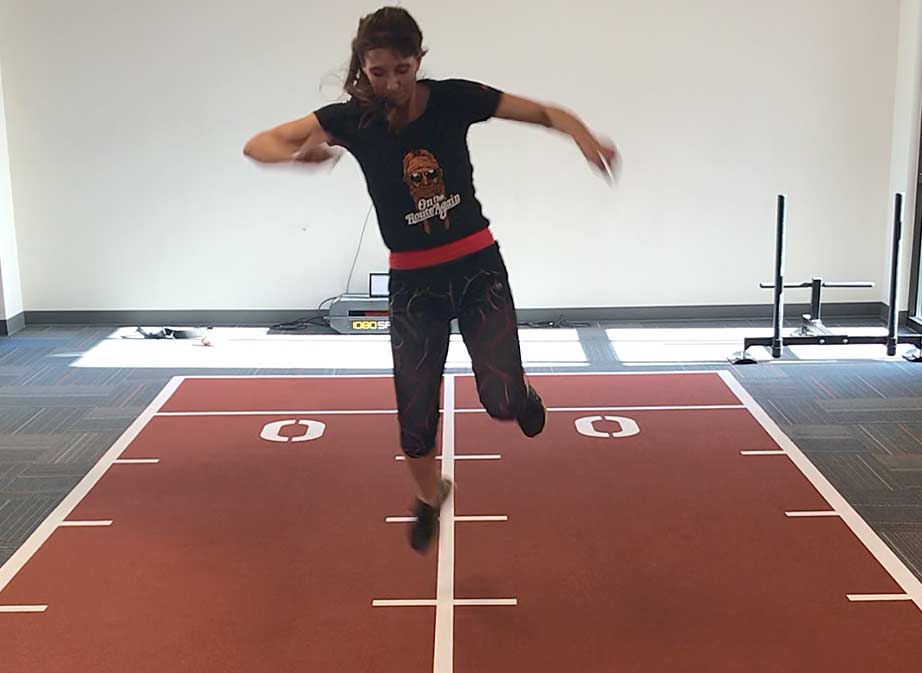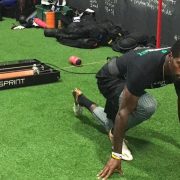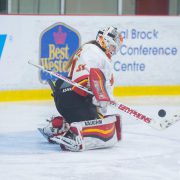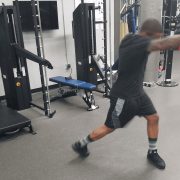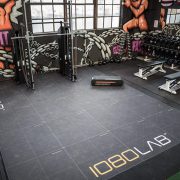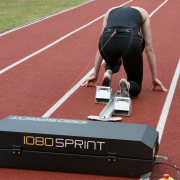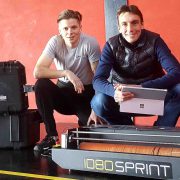Our facility serves as a training ground and rehabilitation center for athletes. I train healthy athletes to be faster, more explosive, and less likely to get hurt; meanwhile, our team of physical therapists treats injured athletes to guide a safe return to play.
If you look closely at the previous two sentences, you’ll see an overlap of responsibilities between myself and the therapists: we both work with athletes to minimize the likelihood of injury. The primary difference is that our PTs are (usually) working to prevent reinjury, whereas I am (usually) working to prevent an injury from happening in the first place.
Working alongside passionate and dedicated therapists has afforded me many learning opportunities. Along the way, I’ve discovered the end of rehabilitation often looks a lot like training. This is certainly true for anterior cruciate ligament (ACL) tear rehab.
The final phase of rehab for an ACL tear involves increasing power production and adding a healthy dose of plyometrics. The primary goal is to decrease the likelihood of sustaining another ACL tear.
Return-to-play (RTP) protocols are used to determine if an athlete is at increased risk for injury, such as an ACL tear. While there are several RTP protocols for an ACL tear, they are not standardized and the athlete’s readiness to safely return to sport is often left to the subjective judgment of the rehab professional.
Recognizing there is great value in clinical intuition and experience, data driven outcomes are more reliable, easier to engage the athlete, coach, and parent, and will reduce the risk of inadvertently returning an athlete to sport before he or she is ready.
Specifically, unilateral power production informs athlete readiness to get back on the court or field.
Power production should be symmetrical between legs, although the traditional standard is at least 90% symmetry as measured by the limb symmetry index (LSI) before clearing for sport. There can be exceptions made to this, yet it is only with a true LSI than an informed exception can be made.
We use the 1080 to directly measure power in four RTP tests to ensure our athletes are prepared and at the lowest possible risk for re-injury.
1. Single-Leg Broad Jump
Most of the power in a single-leg broad jump is generated from the concentric power production capabilities of the muscles themselves, with relatively little contribution from the elastic components that rely on the stretch shortening cycle. Thus, this movement gives insight into muscular power production potential.
2. Triple Hop
Unlike the single-leg broad jump, the triple hop does make use of a stretch shortening cycle. Because ground contact time is limited on the second and third hop, power production is a key determinant of performance.
3. Crossover Hop
The crossover hop is similar to the triple hop, but the athlete crosses over a midline at a roughly 45° angle, thus experiencing medial and lateral forces at the knee in accordance with the direction of the jump. Again, the standard is an LSI of over 90%.
Further, this movement is more dynamic than linear hopping and challenges knee control to a greater degree. Power outputs can be downregulated as a compensation strategy for a lack of control or comfort with a movement. Thus, even if knee mechanics are strong in this movement, if the power produced is much lower than that of the triple hop, that is a sign the athlete does not have mastery of single-leg lateral movement.
4. Sprinting
The hallmark of athleticism: sprinting.
Because the 1080 measures each stride, it’s easy to see if one leg is less powerful than the other when sprinting.
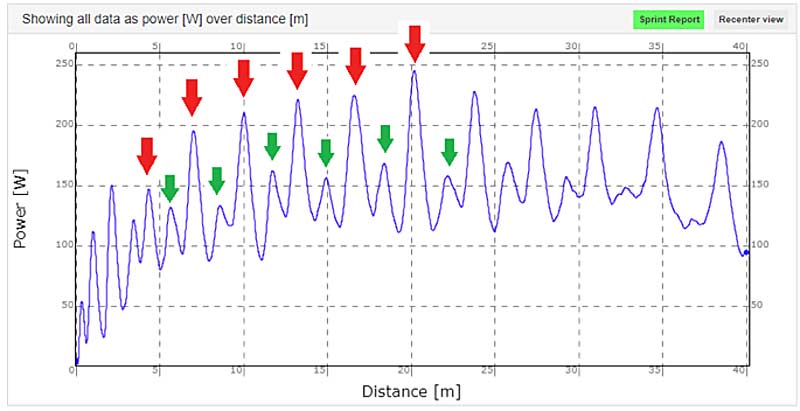
Each peak on the graph represents a single stride. By looking at the graph, the power asymmetry is obvious. Interestingly, when watching this athlete run, nothing stood out as irregular. Despite normal looking mechanics, this athlete had a significant power production asymmetry when sprinting.
Measuring Symmetry
Let’s take a moment to look at a power asymmetry presented in jump data (which is displayed differently than sprint data).
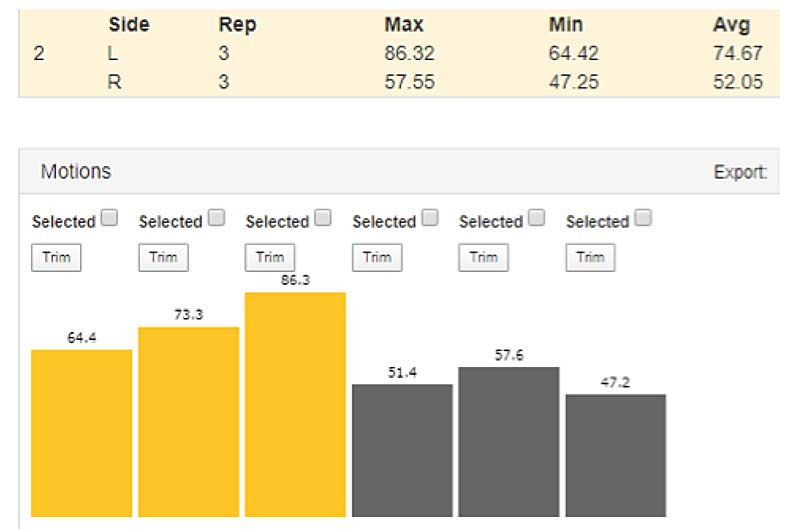
The yellow boxes represent the left leg, the gray boxes represent the right leg, and each box represents a single rep of a unilateral exercise. Thus, here we see the data from three reps per leg.
The asymmetry is easy to spot. On average, the left leg generated 74.67 Watts of power, while the right leg generated just 52.05 Watts. This represents a limb symmetry index (LSI) score of just 69.7%—and, as mentioned earlier, 90% symmetry is the standard for RTP protocols (LSI is calculated by dividing the injured leg performance by the non-injured leg performance and multiplying the quotient by 100).
Note also that power is distinct from jump distance. Power is force x velocity, or work/ time. Even if each leg hops similar distances, that does not necessarily mean the jumps were symmetric in power. Jump distances can be accounted for by compensations, whereas power production is a direct measure of physiologic muscular performance.
Thus, measuring power uncovers deeper rooted asymmetries than simple jump distance can.
Return to Sport Criteria
Our criteria to clear an athlete for sport is simple: a power production LSI of over 90%, coupled with quality knee mechanics on all tests. Athletes scoring an LSI below 90% or performing the tests without demonstrating sound knee control are at increased risk for tearing an ACL and are not cleared for sport.
This should be of note to strength and performance coaches. The purpose of an RTP protocol is to assess injury risk. Thus, an athlete who hasn’t torn an ACL but registers an LSI below 90% on these tests is indeed at increased risk for an ACL tear. Coaches seeking to prevent ACL tears can easily incorporate these tests to flag at-risk athletes. What’s more, coaches training athletes who have previously torn an ACL can uncover asymmetries that were not corrected during rehab. This information can guide your programming to reduce asymmetry and make the athlete less likely sustain another ACL tear. Exactly how to correct such asymmetries is beyond the scope of this article and is heavily influenced by your personal biases and training philosophies, but an easy place to start is programming more volume of power work—such as hopping—on the lagging leg.
1080 Sprint: An Invaluable Tool
Without the insights the 1080 provides, we’d be left guessing at the kinetic drivers of kinematic function. Power is not easy to measure, yet is a critical factor in athletic performance. Asymmetrical power production potential is not ideal from a performance or injury prevention standpoint. Measuring and tracking those variables are paramount to providing the highest quality of service to your athletes. Using the 1080 to test and train your athletes separates you from the pack and elevates the level of care you provide.
Ultimately, the result is a stronger, safer athlete. What more can we ask for?
The above article was written by Kyle Davey. Kyle offers personal training in Salem, OR, as well as performance training, remote strength and conditioning for team sport organizations, performance analysis, consulting, and writing. Kyle has special interests in speed development, injury prevention, and performance analysis. He owns the Salem Personal Training and Speed Academy, where he provides high level training for athletes and adults alike.
You can find Kyle on Twitter, LinkedIn, and Instagram
